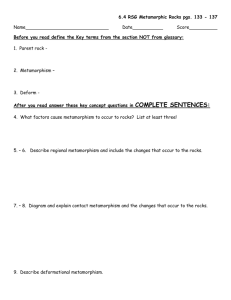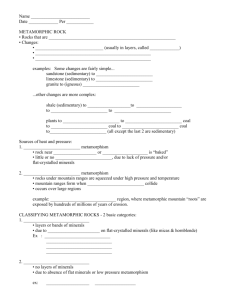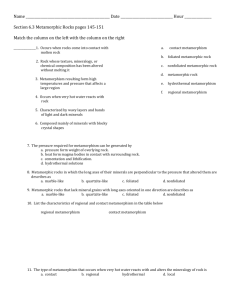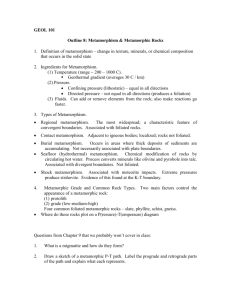Chapter 6 Metamorphism and Metamorphic Rocks Metamorphism
advertisement
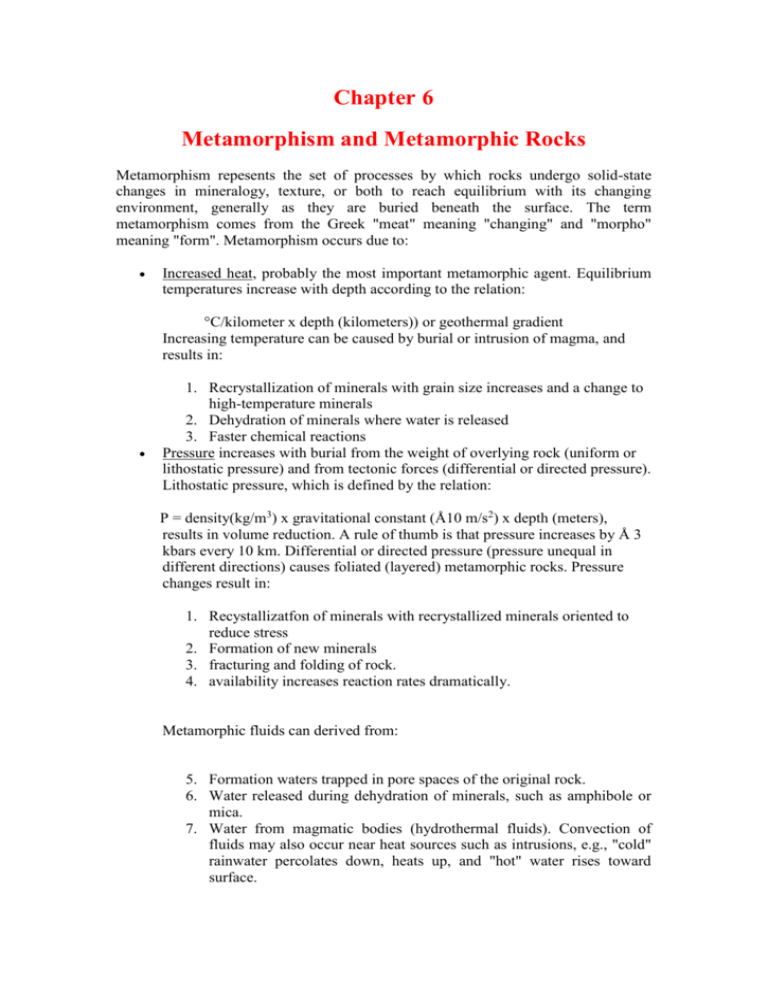
Chapter 6 Metamorphism and Metamorphic Rocks Metamorphism repesents the set of processes by which rocks undergo solid-state changes in mineralogy, texture, or both to reach equilibrium with its changing environment, generally as they are buried beneath the surface. The term metamorphism comes from the Greek "meat" meaning "changing" and "morpho" meaning "form". Metamorphism occurs due to: Increased heat, probably the most important metamorphic agent. Equilibrium temperatures increase with depth according to the relation: °C/kilometer x depth (kilometers)) or geothermal gradient Increasing temperature can be caused by burial or intrusion of magma, and results in: 1. Recrystallization of minerals with grain size increases and a change to high-temperature minerals 2. Dehydration of minerals where water is released 3. Faster chemical reactions Pressure increases with burial from the weight of overlying rock (uniform or lithostatic pressure) and from tectonic forces (differential or directed pressure). Lithostatic pressure, which is defined by the relation: P = density(kg/m3) x gravitational constant (Å10 m/s2) x depth (meters), results in volume reduction. A rule of thumb is that pressure increases by Å 3 kbars every 10 km. Differential or directed pressure (pressure unequal in different directions) causes foliated (layered) metamorphic rocks. Pressure changes result in: 1. Recystallizatfon of minerals with recrystallized minerals oriented to reduce stress 2. Formation of new minerals 3. fracturing and folding of rock. 4. availability increases reaction rates dramatically. Metamorphic fluids can derived from: 5. Formation waters trapped in pore spaces of the original rock. 6. Water released during dehydration of minerals, such as amphibole or mica. 7. Water from magmatic bodies (hydrothermal fluids). Convection of fluids may also occur near heat sources such as intrusions, e.g., "cold" rainwater percolates down, heats up, and "hot" water rises toward surface. Time which the other 3 agents of metamorphism act on a rock can determine the extent of the changes in the rock. Coarse-grained rocks probably result from longer periods of metamorphism. Types of Metamorphism There are three major types of metamorphism: 1. Contact Metamorphism occurs when molten rock comes in contact with cooler rock. Metamorphism occurs primarily due to heat (up to 900°C) and chemically active fluids. Produces a local zone of alteration in the surrounding rock called an aureole. This aureole contains minerals diagnostic of contact metamorphism and produces a fine-grained non-foliated rock known as hornfels. Fluids released can react with country rock (hydrothermal alteration) to produce new metamorphic minerals and ore deposits. 2. Dynamic Metamorphism is metamorphism associated with fault zones where rocks are subjected to high differential pressures. Produces rocks called mylonites (hard, dense, fine-grained rocks often characterized by thin laminations) . 3. Regional Metamorphism results from intense compression, deep burial, and large igneous intrusions commonly related to mountain building (convergent plate margins). Most metamorphic rocks are produced by this type of metamorphism (area affected is very large). Rocks are foliated with mineral assemblages characteristic of varying metamorphic temperatures and pressures. Textural Changes During Metamorphism Grain size increases with increasing temperature, but decreases as directed pressure increases. Directed pressure causes development of foliation, where mineral grains are arranged into layers. Chemical and Mineralogical Changes During Metamorphism Metamorphism is isochemical where mineralogical changes due variations in temperature and pressure is accompanied by no change in rock chemistry. Metasomatism or metamorphism resulting from widespread movement of chemically active fluids results in significant changes in rock chemistry Metamorphic facies are assemblages of minerals reflecting different metamorphic environments. Each facies correlates to a specific range of temperature and pressure. These facies can be thought of as regions on a pressure-temperature diagram, and are given distinctive names: zeolite, blueschist, greenschist, amphibolite, granulite, and eclogite. Index Minerals are metamorphic minerals characteristic of specific temperature and pressure conditions in metamorphosed rocks (e.g., staurolite at ca. 500 - 650°C). Isograds (lines of similar temperature-pressure conditions) are drawn on maps to separate one metamorphic zone of index minerals from another. Isograds in contact metamorphic rocks will subparallel contacts with plutons (heat source), whereas isograds of regional metamorphism may subparallel the surface. What Types of Metamorphic Rocks Form? Metamorphic rocks are found in mountain ranges, roots of mountain ranges, and on continental shields (the stable cores of continents that contain the oldest known rocks, 3.96 billion years old). Regional metamorphic rocks are much more widespread than contact metamorphic rocks. Classification is based on texture and composition. Rocks are commonly divided into two groups : Foliated Rocks show distinct planar texture due to alignment of mineral grains. 1. Slate - Fine-gained rock produced by low-grade metamorphism of shale. Shows slaty cleavage and many possible colors. 2. Phyllite - Platy minerals larger than in slate, but not easily seen. The rock, produced by slightly higher grade (temperature) metamorphism than slate, has glossy sheen. 3. Schist - Distinctly foliated rocks with visible mineral grains most commonly produced by regional metamorphism of clay-rich sedimentary rocks. Contain >50% platy minerals. Produced by intermediate-grade metamorphism. Named according to major minerals. Most abundant regional metamorphic rock. 4. Gneiss - Coarse-grained granular rock with alternating bands of light (quartz and feldspar) and dark (biotite and hornblende) minerals. Produced by highgade metamorphic conditions. 5. Amphibolite - Medium- to coarse-grained, dark-colored rock composed largely of amphibole (hornblende) and plagioclase. Produced by medium- to high-grade metamorphism of basic rocks. Weak foliation. 6. Migmatites - "Mixed rocks" having both igneous and metamorphic characteristics. Produced by extremely high-grade metamorphism which produces local melting or complete segregation of low-temperature minerals. Look like schists that have been intruded by granite. Migmatites tend to have a granitic composition. Can follow some rock units from unmetamorphosed sediment to migmatite to pure granite. Nonfoliated rocks formed by regional metamorphism of monomineralic rocks or contact metamorphism.Show no preferred orientation. 1. Marble - Recrystallized limestone or dolostone. Sugary texture. 2. Quartzite - Metamorphosed quartz-rich sandstone. Sugary, interlocking texture. 3. Greenstone - Any compact, dark-green, non-foliated mafic metamorphic rock. Color is produced by chlorite, epidote, or amphibole minerals. 4. Hornfels - Any fine-grained rock produced by contact metamorphism. Density of rock increases with metamorphic grade. 5. Anthracite - Shiny black coal produced by metamorphism of lower grades of coal. Highest carbon content and lowest impurity content of any type of coal. Metamorphism and Plate Tectonics Metamorphism is associated with all 3 types of plate boundaries, but is most common at convergent plate margins. A. Convergent boundary metamorphism can produce: 1. Melanges, a mixture of sea floor sediments, ocean crust fragments, and various low-temperature high-pressure metamorphic assemblages (blueschist facies). 2. Low- to high-grade regional metamorphism of fore- and back-arc sediments. 3. Contact metamorphism occurs around intrusions produced by magmas that originate through melting above the subducting slab. B. Divergent boundary metamorphism can produce: 1. Contact metamorphism from extrusion of basaltic lava. 2. Mineralization from hydrothermal solutions (black smokersj. C. Transform boundary metamorphism produces mineral recrystallization mainly due in changes in directed pressures. Metamorphism and Natural Resources Metamorphism produces many valuable mineral and rock resources: A. Rocks quarried include: 1. Marble which is used for statuary and ornamental building stone. 2. Slate which is used for roofing, flooring, billiard/pool tables, and blackboards. B. Important economic metamorphic minerals include: 1. Talc which is ground into powder. 2. Graphite used in pencils and lubricants. 3. Garnet and Corundum used as gemstones and abrasives. 4. Asbestos formerly used as a heat insulator. 5. Kyanite, Andatusite, Sillimanite used a raw material in the ceramics industry. C. Ore Deposits - result from contact metamorphism where hydrothermal solutions precipitate ore minerals in surrounding rocks: 1. Sulfide deposits (bornite, chalcopyrite, galena, pyrite, and sphalerite) 2. Iron and Tin Oxides deposits (hematite, magnetite, and cassiterite) 3. Tungsten deposits (wolframite and scheelite) 4. Precious metal deposits (gold)





